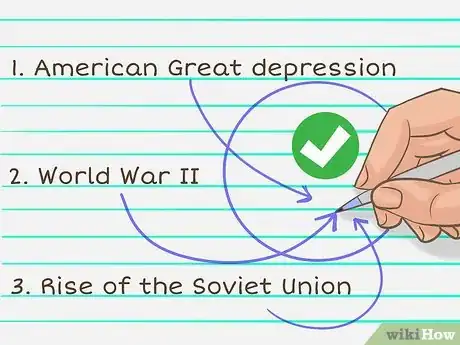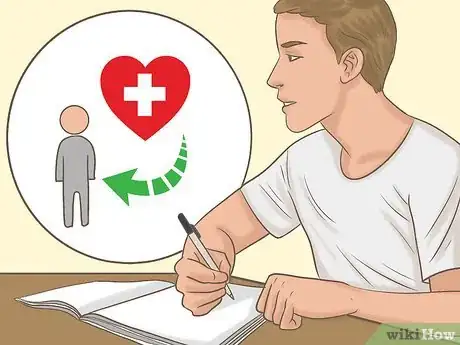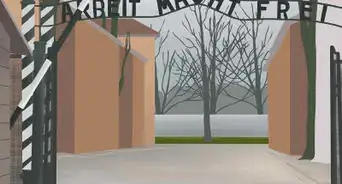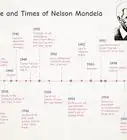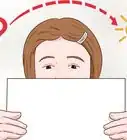This article was co-authored by Carrie Adkins, PhD. Carrie Adkins is the cofounder of NursingClio, an open access, peer-reviewed, collaborative blog that connects historical scholarship to current issues in gender and medicine. She completed her PhD in American History at the University of Oregon in 2013. While completing her PhD, she earned numerous competitive research grants, teaching fellowships, and writing awards.
There are 12 references cited in this article, which can be found at the bottom of the page.
This article has been viewed 33,154 times.
Studying history can be pretty straightforward and even enjoyable if you apply yourself both in and out of the classroom. Whether you have a big test coming up and you’re attempting to cram the night before, or you’re looking to brush up on your studying skills for history courses in general, there are a few things you can do to prepare. Take notes during lectures and when reading the assigned texts, and don’t hesitate to ask (or email) your instructor, professor, or teacher if any questions arise.
Steps
Taking Effective Notes
-
1Ask your instructor what type of information they'll include on exams. Taking good notes is much easier if you know what's important. Each instructor has their own way of designing their exams, so you may need to change up your note taking strategy to fit their assessments.
- This information may also be included on the syllabus.
-
2Write down important information from your teacher and textbook. It may feel redundant to take notes in class, since the information is on the board in front of you. However, you’ll soon forget the facts and dates if you don’t write them down straight away. The same goes for when you’re reading the assigned text(s) for the course/class. So, keep a notebook dedicated to history classes, and aim to take at least 1 page of notes per chapter read or 30 minutes of lecture you've sat through.[1]
- For example, you may not need to write down Abraham Lincoln’s exact height. But, you should jot down the dates of the Civil War and the date of the Gettysburg Address, for example.
Advertisement -
3Organize your notes chronologically. It goes without saying that the field of history comprises many events that took place in a certain chronological order. Maintaining that chronology in the notes that you take both in class and while reading will help you organize the information you receive. Always jot down the date of events in your notes and try to keep things sequential.[2]
- For example, if you’re studying the Cold War, organize major events like the Manhattan Project, the Cuban Missile Crisis, and the fall of the Berlin Wall in the order in which they occurred.
- Use several resources to ensure the accuracy of your historic research.
-
4Write down connections between the chronological notes you take. Studying history can often feel like you’re memorizing a bunch of disconnected dates, names, and places. Avoid this by making the connections explicit in the notes that you take. Then, when you’re preparing for a test or essay, you’ll be able to draw on these connections and contextualize historical events.[3]
- For example, write down causal links between major 20th century events like the American Great Depression, World War II, and the rise of the Soviet Union.
-
5Make a visual map of interconnected historical events. This can be a timeline, a flip book, or what-have-you. If you are a visual learner, retaining written information can be a challenging task; try mapping out historical events on a few sheets of note paper instead of writing them down. If you’re studying the Cold War, write “cold war” in the center and draw several lines out around it that draw in American presidents, Soviet leaders, and major events.[4]
- Make sure to add a date near each of the events and figures on the map. So, when you write “Cuban Missile Crisis,” add “October, 1962.”
- Don't include information you do not need.
-
6Ask your instructor about any information you didn’t understand. Sometimes students feel embarrassed to ask their teacher questions, but there’s no reason to feel that way. If you’re confused about a point in the lecture or are struggling to remember any dates, names, or places, don’t hesitate to ask your teacher after class.[5] Or, send your teacher an inquiring email that night.
- So, try asking something like, “I’m having a hard time remembering the names of the Soviet leaders. Can you remind me who came after Stalin?”
Retaining Key Information
-
1Focus on remembering big-picture events and concepts. When reading and studying history, it’s easy to get bogged down on little details. This makes it nearly impossible to retain the information you’ll need to pass a test or write an essay. Instead, focus on the big-picture topic (e.g., the course topic and sub-topics) and think of smaller events only as they relate to the major topic.[6] This will hone your understanding of the material.
- For example, if you’re spending 6 weeks studying the American Civil War, don’t try to remember the names of every battle and military movement. Instead, focus on remembering 4-5 major figures on both sides, 4-5 major battles, and the war’s political causes and fallout.
-
2Draw a timeline of the historical period that you’re studying. A timeline is a great visual aid when it comes to understanding the sequence and chronology of historical events. So, if you’re studying 20th century history, label a line from 1900 to 1999, and fill it in with major events like the World Wars, Cold War, and Vietnam War. Also add events like the invention of the internet and the assassination of JFK.[7]
- If the timeline becomes too long to fit on a sheet of notebook paper, try using a strip of butcher paper instead.
- If you have access to a digital device, try making your timeline online using a fun template. You can find a good template with a simple online search.
-
3Memorize necessary dates and names using flash cards. While making connections between chronological events is great, sometimes you just need to memorize historical data. Try writing a small prompt on the front of the card and the answer on the back. Then, you can quiz yourself during your daily study time. Or, get together with a couple of friends from your history class and quiz each other in preparation for the test.[8]
- For example, on the front of the card, write “Where was JFK shot?” and on the back write “Dallas, Texas.”
EXPERT TIPCarrie Adkins is the cofounder of NursingClio, an open access, peer-reviewed, collaborative blog that connects historical scholarship to current issues in gender and medicine. She completed her PhD in American History at the University of Oregon in 2013. While completing her PhD, she earned numerous competitive research grants, teaching fellowships, and writing awards.PhD in American History, University of Oregon
 Carrie Adkins, PhD
Carrie Adkins, PhD
PhD in American History, University of OregonHow do the important people relate to one another? Carrie Adkins, PhD in History, tells us, "It’s much easier to remember people’s names if you know why those people are important and how they're related to each other — if, basically, they become characters in a story you know."
-
4Relate the topics you're studying to your own life. Connecting historical events and ideas to your everyday life can help you understand them on a deeper level. Examine how history still affects society today, and look for incidences in your life that mirror historical events.
- For example, let's say you're studying slavery in the United States. You might review current events to see how society is still impacted by the past practice of slavery.
-
5Imagine what life was like during the time period you're studying. As you study each topic, close your eyes and imagine you're there. Try to form a picture based on what you've learned so far. Then, ask yourself questions like these:
- How might you go about your day?
- What would you expect to see, hear, feel, smell, and taste?
- What struggles might you face?
- Who would you expect to meet?
- How would you feel? Afraid? Excited? Interested?
Studying for a Test or Quiz
-
1Skim the history textbook if you’re studying last-minute. If your test is coming up shortly, you may not have time to study with flash cards or get a group together. Instead, study quickly by skimming the texts. You’ll absorb the most information if you focus on titles and headings rather than getting bogged down in paragraphs. Try to absorb major names, dates, events, and places in time for the test.[9]
- So, start by reading the titles of the chapters you’ll be tested on. Go through the chapters and read major sections and sub-headings. Then read the introductory and concluding paragraphs to each of those chapters.
-
2Review and rewrite notes that pertain to the topic of the test. Unless you’re studying for a final exam, quizzes and tests will only be on a portion of the course material. So, open your history notebook and pull out your notes that pertain to the test topic. Re-read everything you wrote. Then, make a 1-2 page outline of all the major events, dates, and people that will likely be on the test.[10]
- If anything in your notes isn’t clear to you, go back and re-read the section of your textbook that the information came from.
- Or, ask your teacher for clarification if the information came from an in-class lecture.
-
3Make—and stick to—a daily study schedule. Studying for a history exam may not be the most thrilling way to spend a couple of hours, and students often postpone studying. If you postpone too many times, though, you won’t end up studying enough to pass the test. So, set aside 1-2 hours each day during which you can review your lecture notes, re-read relevant parts of the class texts, and use flash cards.[11]
- For example, study history from 8:00 to 9:30 every night. Once it’s a habit, it’ll feel as normal as any other part of your routine.
-
4Invite other students to join you in a study group. When studying for a test, try getting a few other classmates to join you at someone’s house or the school library. You and the other group members can ask each other questions about the course content, refer to each other’s notes, and help jog one another’s memories regarding names, dates, and facts. Or, pull out your notecards and review them with your classmates.[12]
- Many group-study sessions become little more than a social hour. Avoid this by keeping the members of your group focused on studying history.
References
- ↑ https://learningcenter.unc.edu/tips-and-tools/effective-note-taking-in-class/
- ↑ https://learningcenter.unc.edu/tips-and-tools/taking-notes-while-reading/
- ↑ https://learningcenter.unc.edu/tips-and-tools/enhancing-your-memory/
- ↑ https://learningcenter.unc.edu/tips-and-tools/using-concept-maps/
- ↑ https://ctl.wustl.edu/resources/asking-questions-to-improve-learning/
- ↑ https://learningcenter.unc.edu/tips-and-tools/enhancing-your-memory/
- ↑ https://history.wisc.edu/undergraduate-program/history-careers/why-history/
- ↑ https://www.psychologytoday.com/us/blog/radical-teaching/201609/memorizing-faster-easier-longer-lasting-and-more-fun
- ↑ https://www.umassd.edu/dss/resources/students/classroom-strategies/how-to-skim/
About This Article
To study history, skim your history textbooks if you’re short on time before a test. For example, aim to read the chapter titles of the topics you’ll be tested on, the introductions and conclusions of each chapter, and the remaining subheadings, which will give you a rough overview of the subject. Aim to focus on remembering the big picture events, like the 3 most important battles in the American Civil War, so you don’t get bogged down in detail. If you have a bit more time, ask your instructor what type of information they’ll include in exams so you know what to focus on when you're studying. You should also write down notes of important dates and events in class, since you won’t have the board to look at when you’re studying at home. As your notes build up, try to keep them chronological, which will make it easier for you to find information about a specific period of time. Additionally, write down any connections between the different notes you take, since you'll find it easier to remember various events if you can link them together. For tips from our Education co-author on how to draw a historical timeline, read on!



